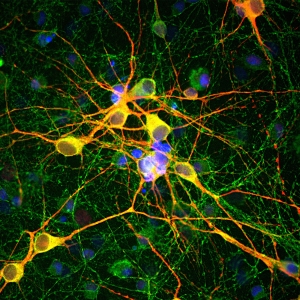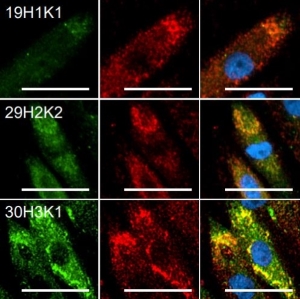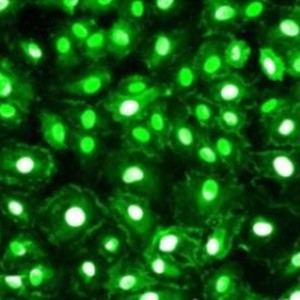Product Details
Product Sizes
| Size | List Price | Price | Cart |
|---|---|---|---|
| 100 ul | $325.00 | Add to Cart |
Lamins function as skeletal components tightly associated with the inner nuclear membrane. Originally the proteins of the nuclear cytoskeleton were named Lamin A, B and C, from top to bottom as visualized on SDS-PAGE gels. Subsequently, it was found that Lamins A and C were coded for by a single gene, while the Lamin B band may contain two proteins encoded by two genes now called Lamin B1 and Lamin B2. Lamin A has a mass of about 74kDa while Lamin C is 65kDa. The Lamin A protein includes 98 amino acids missing from Lamin C, while Lamin C has a C-terminal 6 amino acid peptide not present in Lamin A. Apart from these regions Lamin A and C are identical so that antibodies raised against either protein are likely to cross-react with the other, as is the case with this monoclonal. The activity of this kinase increases during cell division and is responsible for the breakdown of the nuclear lamina. Mutations in the LMNA gene are associated with several serious human diseases, including Emery-Dreifuss muscular dystrophy, familial partial lipodystrophy, limb girdle muscular dystrophy, dilated cardiomyopathy, Charcot-Marie-Tooth disease type 2B1, and Hutchinson-Gilford progeria syndrome. This family of diseases belongs to a larger group which are often referred to as Laminopathies, though some laminopathies are associated in defects in Lamin B1, B2 or one or other of the numerous nuclear lamina binding proteins. A truncated version of lamin A, commonly known as progerin, causes Hutchinson-Gilford progeria syndrome, a form of premature aging. |
Images
HeLa cells staing with Lamin A/C (red), and counterstained with chicken polyclonal Vimentin antibody (CH22108) to (green) and DNA (blue). The antibody reveals strong nuclear lamina staining, while the Vimentin antibody reveals cytoplasmic intermediate filaments. Protocol on datasheet.
Stripe blots of crude HeLa cell extract stained with Lamin A/C. Note two strong clean bands at 74kDa and 64kkDa, corresponding to Lamin A and C, in the lane labeled 6. Lane 5 was stained with our antibody to Enolase 1, which we will market shortly. Lanes 3 and 4 were reacted with Actin, our monoclonal antibody to all six actin isotypes. Molecular weights of each protein are as indicated. Protocol on datasheet.






